- Submissions

Full Text
Advances in Complementary & Alternative medicine
Effect of Aromatherapy Combined with Music Therapy Vs Music Therapy on Anxiety, Cognition, Sleep Quality and Positive and Negative Affectivity in Students: A Randomized Control Trial
Sai Anirudh*
Department of Yoga and Naturopathy, Ccryn-Cmbiy at Aiims Raipur, India
*Corresponding author:Sai Anirudh, Department of Yoga and Naturopathy, Ccryn-Cmbiy at Aiims Raipur, India
Submission: July 04, 2025;Published: August 11, 2025

ISSN: 2637-7802 Volume 8 Issue 5
Abstract
Aims of the study: The aim of the study is to compare the effect of aromatherapy combined with music
therapy and music therapy only on exam anxiety, cognition, sleep quality and affectivity among students
who are facing their main exams.
Materials and methods
Participants: The study was conducted on 54 medical students of age group from 18 to 23 years.
Design: A randomized controlled study was conducted on 54 participants at residential medical college.
Method: 72 participants were screened to take part in the study. Out of 72 participants, 54 participants
were eligible for the study based on the inclusion and exclusion criteria. After informing about the
study and obtaining consent form from the participants, all 54 participants were randomly assigned to
aromatherapy combined with music therapy group (n=18), only music therapy group (n=18) and control
group(n=18). The intervention in the aromatherapy combined with music therapy group was inhalation
of chamomile-lavender mixed aroma while listening to Beethoven’s moonlight sonata using noisecancellation
earphones for 20 minutes for consecutive five days.
Results: Aroma therapy combined with music therapy had a significant effect on exam anxiety (F=42.770,
p=< 0.001), cognition (F=0.821, p=0.017), sleep quality (F=29.301, p=< 0.001), and positive affectivity
(F=4.266, p=0.019) compared with music therapy alone as an intervention.
Conclusion: Aromatherapy combined with music therapy helped more in reducing exam anxiety
and improving the quality of sleep, cognitive functions and positive affectivity in the college students
compared to music therapy groups.
Keywords:Aromatherapy; Music therapy; Anxiety, Sleep; Cognition; Positive and negative affectivity
Introduction
Worldwide research studies show that problematic exam anxiety is rising among students and the magnitude ranges from 25 to 40% in undergraduate medical students and has an impact on their academic performance and success [1] students face various challenging situations and sudden changes in social environment after attending college along with family separation which leads to stress and anxiety which also cause different cognitive and emotional problems in them [2]. Recent studies observed that there are problems of anxiety [3], cognitive deficit [4], poor sleep quality [5] and negative affectivity [6] faced by students. It was observed that anxiety is positively related to having poor grade point average, excessive course load, oral examination, lack of study plan, poor social support, moderate social support and psychological distress [7], is a combination of physical symptoms and emotional reactions that interfere with one’s ability to perform well on tests. Research shows that sudden changes in Socioenvironmental conditions among college students lead to self-imposed stress and sleep problems.
It’s affecting students’ health conditions and academic performance [8]. It was found that very high prevalence of stress and poor sleep quality in college students and poor sleep quality strongly associated with stress condition [9]. Academic stress is also positively related to negative effects in college students [10]. Scientific evidence also supports that there is negative correlation between sleep quality and negative effects. Those individuals having lower sleep quality tend to have higher negative effects [11]. The development and validation of complementary alternative methods of interventions to improve cognitive functions and sleep quality, to minimize the test anxiety and negative affectivity and enhance positive affectivity has been growing [12]. Among those interventions, aromatherapy and music therapy are of specific interest. Aromatherapy is a type of complementary and alternative medicine that uses plant oils that are aromatic which helps in promoting relaxation, well-being, healing and therapeutic benefits [13]. It enhances relaxation and concentration using essential oils extracted from flowers, stems, roots and leaves of plants. Inhalation of essential oils can communicate signals to the olfactory system and stimulate the brain to exert neurotransmitters like serotonin and dopamine and thus reduce anxiety, regulating mood, improving cognitive functions and improving the quality of sleep [14].
Another intervention, Music therapy is a technique of complementary medicine that uses music prescribed in a skilled manner by trained therapists to improve mental health and over-all wellbeing [15]. Listening to calm and slow tempo music in fluences the autonomic nervous system and the neuro-endocrine system which in turn reduces anxiety and facilitate relaxation by affecting the limbic system of the brain, which is responsible for controlling emotions [16]. Therefore, this study will become paring the effect of music therapy and music therapy combined with aromatherapy interventions which will be addressing test anxiety, improving cognitive functions, the quality of sleep and enhancing mood among students who experience anxiety, sleep disturbances, low mood and poor concentration prior to their exam.
Aims and Objectives
Aim of the study
The aim of the study is to compare the effect of aromatherapy combined with music therapy and music therapy on anxiety, cognition, sleep quality, positive affectivity and negative affectivity among students who are going to face their main exams.
Objectives of the study
a. To evaluate the changes in anxiety level
b. To evaluate the changes in cognitive functions
c. To evaluate the changes in sleep quality
d. To evaluate the changes in positive and negative affectivity
e. To compare the effect of aromatherapy combined with
music therapy and music therapy on test anxiety, sleep quality,
cognition and positive and negative affectivity in students who
are facing their main exams.
Justification of the study
Students who are facing their exams often experience exam anxiety which might impair their cognitive function, decrease their sleep quality and alter their mood. Aromatherapy and music therapy can be used as a home remedy, is easily accessible and cost effective. Thus, this study hypothesized to reduce the exam anxiety level, improve the cognitive functions, improve their sleep quality and enhance their mood.
Hypothesis
Aromatherapy combined with music therapy helps in reducing test anxiety, improving sleep quality, cognitive functions and has positive changes in positive affectivity and negative affectivity in students who are going to face their main exams than music therapy only.
Null hypothesis
Music therapy helps better in reducing test anxiety, improving sleep quality, cognitive functions and has a positive change in positive affectivity and negative affectivity in students who are going to face their main exams than aromatherapy combined with music therapy.
Methods
Participants
Fifty-four undergraduate students, both men and women from a residential medical college participated in this study. Healthy volunteers who were interested in the study were recruited after explaining the protocol and procedure of the study and obtaining the consent.
Sample size
A total of 72 participants were screened. After the screening based on the inclusion and exclusion criteria, 54 participants were selected for the study.
Selection and source of participants
The participants who fulfilled the inclusion and exclusion criteria and who obtained the score of 18 or more than 18 in the Hamilton Anxiety Rating Scale (HAM-S) were selected after one-onone interview from a residential medical college..
Inclusion criteria
a. Students who are 18-25 years old
b. People who are willing to participate in the study
c. People with healthy sense of smell
d. People who have high interest in listening to music and
can listen to music for longtime
e. People who are not using perfume and cologne during the
intervention
f. People who obtained minimum score of 18 in Hamilton
anxiety rating scale
g. People who have disturbed sleep
Exclusion criteria
a. People who are sensitive to aroma oil
b. People with respiratory disease and allergic disease
c. People who are under sedatives, anxiolytics and analgesics
during the study
d. People who have hearing impairments
e. People who are in other relaxation intervention that
affecting their anxiety level
f. People who are diagnosed with a psychiatric disorder or
known to struggle with substance abuse
g. People with any medication which influences cognitive
functions
Ethical consideration
After obtaining the clearance from the CPEB of the university, the subjects were recruited for the study. Each participant was informed about the procedure and protocol of the study, and their queries and doubts were answered. Participants were given the right to withdraw from the study at any point of time and need for the willingness to participate voluntarily in the study was explained. Study was initiated after obtaining the informed consent form from each participant.
Design of the study
The design of the study is randomized control trial. A clinical trial is defined as a prospective experiment involving subjects in whom treatment is initiated for the evaluation of an intervention. Such an intervention may be prophylactic, diagnostic or therapeutic in nature. Essentially, a clinical trial will contain a control group against which the intervention groups are compared. At baseline, control groups must be sufficiently similar in relevant aspects to those intervention groups so that differences in outcome may reasonably be attributed to the action of the intervention (Figure 1).
Figure 1:Study design.
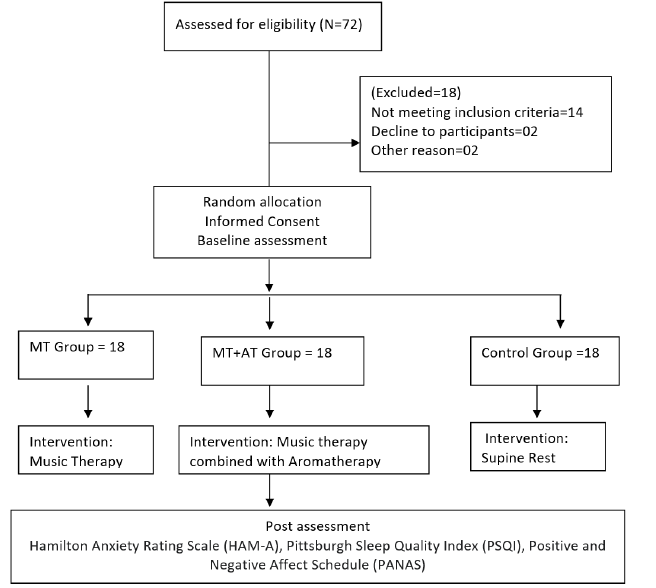
a. Subjects, N =54
b. MT group, n=18
c. MT+AT group, n=18
d. Control group, n=18
e. Intervention duration=3 sessions on alternative days for
ATMT group in 5 days and 5 sessions on consecutive 5 days for
MT group
f. Session duration = 20 minutes
Variables studied
In this study, Hamilton Anxiety Rating Scale (HAM-A),
Pittsburgh Sleep Quality Index (PSQI), Positive and Negative Affect
Schedule (PANAS) and color word strop task using inquisitor 6 lab
software were used to measure the anxiety level, quality of sleep,
positive and negative affectivity and cognition respectively.
Hamilton Anxiety Rating Scale (HAM-A): Hamilton Anxiety
Rating Scale (HAM-A) is one of the first rating scales to measure
the severity of perceived anxiety symptoms. It is a clinician-based
psychological questionnaire which consists of 14 symptom-defined
elements, and caters for both psychological and somatic symptoms,
comprising anxious mood, tension, insomnia, intellectual (poor
memory/ difficulty in concentration), depressed mood, somatic
symptoms, sensory symptoms, cardiovascular, respiratory,
gastrointestinal, genitourinary, autonomic and observed behavior
at interview. Each item is scored on a basic numeric scoring of 0
(not present) to 4 (severe). The calculation of the scoring will yield
a comprehensive score in the range of 0-56. A score of 17 or less
indicates mild anxiety, from 18-24 indicates mild to moderate
anxiety and from 25-30 indicates a moderate to severe anxiety
severity [17].
Pittsburgh Sleep Quality Index (PSQI): Pittsburgh Sleep
Quality Index (PSQI) is a self-report questionnaire that assesses
sleep quality overa1-month time interval. The measure consists of
19 individual items, creating 7 components that produce one global
score and takes 5-10 minutes to complete. Consisting of 19 items,
the PSQI measures several different aspects of sleep, offering 7
component scores and 1 composite score. The component scores
consist of subjective sleep quality, sleep latency, sleep duration,
habitual sleep efficiency, sleep disturbances, use of sleeping
medication, and daytime dysfunction. Each item is weighed on a 0-3
interval scale. The sub-scores are tallied, yielding a global score that
can range from 0-21. A score of 5 or above indicates poor quality of
sleep, the higher the score is, the worse the quality [18].
Positive and Negative Affect Schedule (PANAS-SF): The
Positive and Negative Affect Schedule (PANAS) is a 20-item selfreport
measure assessing levels of positive and negative effect.
The PANAS consists of ten items for positive effect (PANAS-P;
attentive, interested, interested, excited, enthusiastic, inspired,
proud, determined, strong, active) and ten items for negative
affect (PANAS-N; distressed, upset, hostile, irritable, scared, afraid,
ashamed, guilty, nervous, jittery). Participants were asked to rate
how much they felt each emotion that day on a scale from zero to
five, with higher scores indicating greater intensity. Each item is
rated on a 5-point scale of 1 (not at all) to 5 (very much) and takes
approximately 5 to 10minutes to complete. The total is calculated
by finding the sum of the 10 positive items, and thenthe10 negative
items. Scores rangefrom10-50 for both sets of items [19].
Stroop task for cognition: Cognitive performance was assessed
using millisecond software at baseline and after intervention. In
this task, the participants will be given color words written in color
and are asked to identify the color of the word (not its meaning) by
pressing the key as fast as they can without making too many errors.
Reaction time and elapsed time were measured and analyzed [20].
Intervention
The intervention in the aromatherapy combined with music therapy group was inhalation of chamomile-lavender mixed aroma while listening to Beethoven’s moonlight sonata using noisecancellation earphones for 20 minutes for consecutive five days. The participants were lying on the bed or sitting on the chair in an aroma diffused room. The room was diffused with chamomilelavender essential oils mixed at the ratio of 1:1 Meanwhile, the participants in the MT group were made to listen to Beethoven’s moonlights on at using noise-cancellation earphones for 20 minutes for consecutive five days. And the participants in the control group received supine rest for 20 minutes for five consecutive days.
Data Extraction
The above-mentioned questionnaires were distributed to the participants and data were collected through Google form. It was then extracted into a spreadsheet on Microsoft excel. All the components of the questionnaires were individually scored by their searchers based on the scoring rules of each questionnaire.
Data Analysis
Data analysis was done using excel and statistical analysis was done using JASP software. The quantitative data were analyzed by using statistical test, descriptive statistics (mean, SD) ANOVA was done to analyze the pre and post data..
Result
All three groups (ATMT, MT and control group) were assessed before and after the intervention using Hamilton Anxiety Rating Scale (HAM-S), Pittsburgh Sleep Quality Index (PSQI), The Positive and Negative Affect Schedule (PANAS) and Stroop Task. At the end of the study ATMT (P<0.001) and MT (P<0.001) group demonstrated the significant reduction in Anxiety as compared to control group (Table 1). But ATMT group showed (Figure 2) higher percentage changes (55.25%) of reduction in anxiety than MT group (37.33%). (Table 2). The pre and post intervention value of Stroop task shown in (Table 3). There was Significant reduction of the reaction time (P=0.017) and elapsed time (P=0.03) found in ATMT group as compared to MT and Control group. Results also show significant changes in different domains of Sleep quality in (Table 4). ATMT group showed significant improvement in sleep latency (P<0.001), sleep duration (P=0.005), Sleep efficiency (P<0.001), sleep disturbance (P=0.005) and total sleep quality index (P<0.001). The MT group showed significant improvement in sleep quality (P<0.001), sleep latency (P<0.001), sleep efficiency (P<0.001), sleep disturbance (P=0.005), and total sleep quality index (P<0.001). The control group showed significant improvement in sleep quality (P= 0.045), sleep duration (P=0.021) and sleep efficiency (P<0.001). Percentage of changes in different domains of Sleep quality shown in figure (Figure 3) After the study the higher percentage of changes found in positive and negative affectivity in ATMT group as compared to MT and control group (Figure 4) but it was not found statistically significant in all groups (Table 2).
Table 1:Result of HAM-S.

Figure 2:Comparison of all 3 groups concerning pre-test and post-test scores of Hamilton Anxiety Rating Scale (HAM-S).
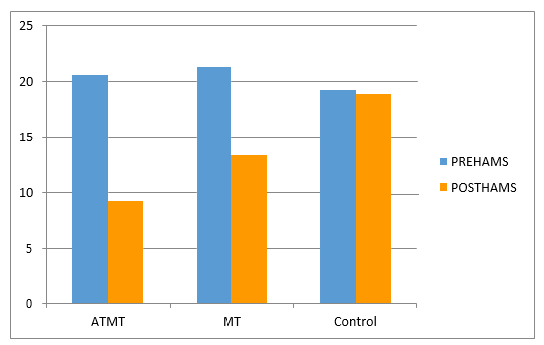
Table 2:Percentage changes of three groups after pre and post data.
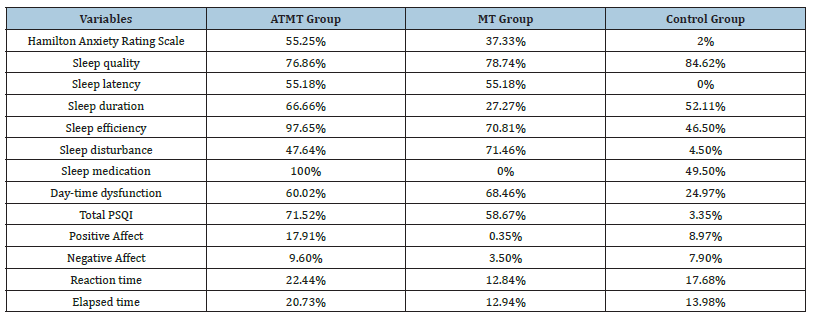
Table 3:Result of stroop task.
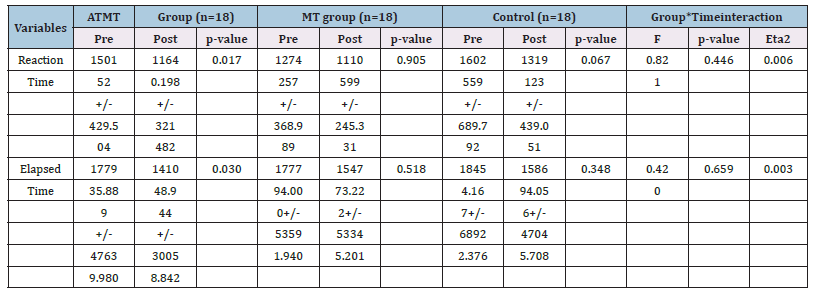
Table 4:Result of PSQI.
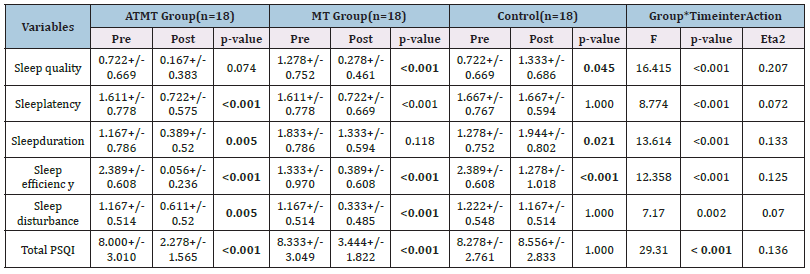
Figure 3:Comparison of all 3 groups respect to pre-test and post-test score of global PSQI.
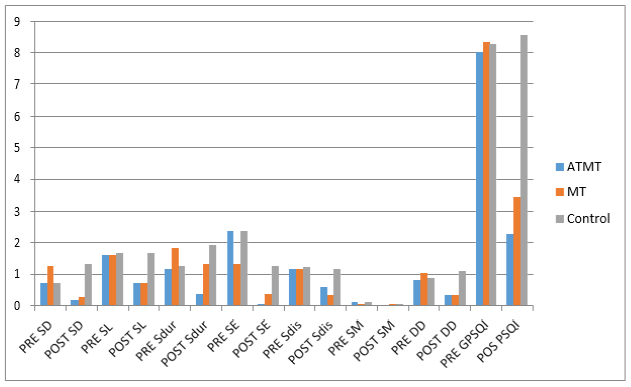
Figure 4:Comparison of all 3 groups respect to pre-test and post-test score of reaction time.

Discussions
This study confirmed the effects of aromatherapy combined with music therapy and music therapy applied separately. Aromatherapy combined with music therapy was associated with a significant decrease in test anxiety, negative affectivity and significant increase in sleep quality, positive affectivity and cognitive function when compared with music therapy group (Figure 5). Excessive test anxiety negatively affects academic performance and has negative impact on students’ssss ability to perform academic tasks. Aromatherapy combined with music therapy has been proven to be an effective strategy to lower student’s level of distraction caused by symptoms of test anxiety. Additionally, music therapy has been confirmed to be an effective diversion therapy to relieve test anxiety and helps in calming their mind under anxious and stressful situations. Previous studies have proven that aromatherapy, music therapy, meditation and other methods of interventions or treatments helps in relieving stress and anxiety. This study is consistent with previous studies, wherein there is a significant difference observed between the ATMT group and MT group. [12,13]. The aroma therapy technique used in this study was in context to the previous studies. The essential oil was diffused by using a diffuser in the room. Essential oils reach their maximum level in the body within 20 minutes of inhalation. So, the intervention is scheduled for 20 minutes. Music was selected based on the previous studies which found music effective for relieving anxiety and elevating affectivity.
Figure 5:Comparison of all 3 groups respect to pre-test and post-test score of elapsed time.
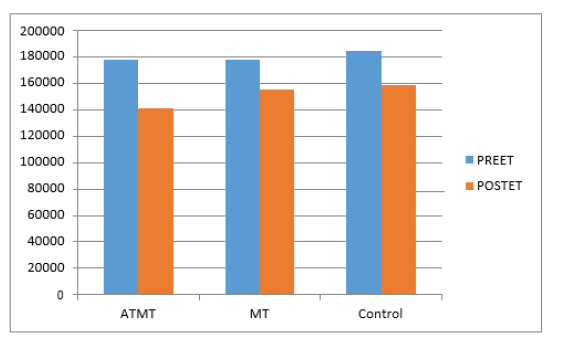
The results of other studies showed that aromatherapy and music therapy were used in different combinations for different samples, where as in the present study, inhalation of lavenderchamomile and Beethoven’s moonlight sonata music for students with test anxiety is a novelty.
Previous studies have proved that GABA neurotransmitter plays an important role in anxiety, sleep cognition and emotional status of an individual [21,22]. Aroma therapy using terpenoid containing oils helps in lowering the anxiety, improving sleep and emotional status by modulating the GABA neuro transmitter system and thus responsible for the sedative, nootropic and anxiolytic effect [23]. Chamomile and lavender essential oils which are good source of terpenoid [24] are used in the present study and thus, regulation of GABA neurotransmitter system helped in reducing the anxiety level, improving sleep quality and cognitive functions and also enhancing the mood [25]. The result of the previous study supports the hypothesis that music can implicitly modulate the subjective experience of an existing negative affective state. The interaction of valanced music and valanced olfaction represents a regulatory process that is “uninstructed, effortless and proceeds without awareness”, which is how implicit emotion regulation can be defined [26].
In this present study, college students aged between 18-23 years were recruited. A three-arm randomized control study was conducted to see the effectiveness of aromatherapy and music therapy in test anxiety reduction, improving sleep quality, cognition and affect levels in college students. 54 participants have volunteered to participate in the study. All have filled the consent forms and were informed about the procedure and benefits of the study. Those 54 participants were randomly distributed into 3 different groups (i.e., ATMT group, MT group and control group). The ATMT group was given intervention for 20 minutes for alternative 3 days in consecutive 5 days, MT group received intervention for 20 minutes daily for consecutive 5 days and the control group received supine rest for 20 minutes for consecutive 5 days. Participants had filled the questionnaires such as Hamilton anxiety rating scale, Pittsburgh sleep quality index, positive and negative affect scale and also did Stroop task at the start and the end of the study. At the end of the study, they had shown a significant change in Hamilton anxiety rating scale, Pittsburgh sleep quality index, positive and negative affect scale and Stroop task in both ATMT and MT group compare to control group. The ATMT has shown better results compared to MT group.
The findings of this study indicated the effect of aromatherapy and music therapy with lavender and chamomile essential oil along with Beethoven’s moonlight sonata in reducing the test anxiety, improving cognitive functions and sleep quality, elevating positive affect and reducing negative affect. Therefore, this method is recommended as a safe, convenient and cost-effective home remedy for test anxiety in students. Further studies should shed more light on the sustainability of benefits obtained as a result of cognitive interventions, affect, sleep and test anxiety levels. Further, welldesigned randomized control trials on ATMT for test anxiety would help in providing mood definitive evidence regarding the efficiency of this method. Additionally, more investigations are needed in order to determine the mechanism underlying aromatherapy and music therapy.
Appraisal
Summary of the findings
The pre-post data within each group was analyzed using repeated ANOVA. There was a significant difference in ATMT group and MT group. However, ATMT showed significant difference when compared to MT group.
Conclusion
The present study has shown a significant change in the Hamilton Anxiety Rating Scale (HAM-S), Pittsburgh Sleep Quality Index (PSQI), The Positive and Negative Affect Schedule (PANAS) and stroop task in both ATMT group and MT group compared to control group. ATMT group has better results than MT group. Hence aromatherapy combined with music therapy help in reducing exam anxiety, improves cognitive function, sleep quality, elevates positive affect and reduced negative affect.
Strength of the study
a. There was a significant improvement in the outcome of
the variables
b. No adverse reaction during the study
c. No dropouts from the study during the intervention
d. Effective randomization
e. Relatively inexpensive
f. Simple, easy and safe intervention
Limitations of the study
a. Questionnaires used were all self-reported questionnaires
b. Male and female are not equally recruited in the group.
References
- Tsegay L, Shumet S, Damene W, Gebreegziabhier G, Ayano G (2019) Prevalence and determinants of test anxiety among medical students in addis ababa Ethiopia. BMC Medical Education 19: 423.
- Pedrelli P, Nyer M, Yeung A, Zulauf C, Wilens T (2015) College students: Mental health problems and treatment considerations. Academic Psychiatry 39(5): 503-511.
- Chapell MS, Blanding ZB, Silverstein ME, Takahashi M, Newman B, et al. (2005) Test anxiety and academic performance in undergraduate and graduate students. Journal of Educational Psychology 97(2): 268-274.
- Hammen CL, Cochran SD (1981) Cognitive correlates of life stress and depression in college students. J Abnorm Psychol 90(1): 23-27.
- Amaral AP, Soares MJ, Pinto AM, Pereira AT, Madeira N, et al. (2018) Sleep difficulties in college students: The role of stress, affect and cognitive processes. Psychiatry Research 260: 331-337.
- Perea CS, Paternina AC, Gomez Y, Lattig MC (2012) Negative affectivity moderated by BDNF and stress response. Journal of Affective Disorders 136(3): 767-774.
- Awadalla S, Davies EB, Glazebrook C (2020) A longitudinal cohort study to explore the relationship between depression, anxiety and academic performance among Emirati university students. BMC Psychiatry 20: 448.
- Valerio TD, Kim MJ, Sexton RK (2016) Association of stress, general health and alcohol use with poor sleep quality among U.S. college students. American Journal of Health Education 47(1): 17-23.
- Almojali AI, Almalki SA, Alothman AS, Masuadi EM, Alaqeel MK (2017) The prevalence and association of stress with sleep quality among medical students. Journal of Epidemiology and Global Health 7(3): 169-174.
- Hara ORE, Armeli S, Boynton MH, Tennen H (2014) Emotional stress-reactivity and positive affect among college students: The role of depression history. Emotion 14(1): 193-202.
- Fortunato VJ, Harsh J (2006) Stress and sleep quality: The moderating role of negative affectivity. Personality and Individual Differences 41(5): 825-836.
- Son HK, So, WY, Kim M (2019) Effects of aromatherapy combined with music therapy on anxiety, stress and fundamental nursing skills in nursing students: A randomized controlled trial. International Journal of Environmental Research and Public Health 16(21): 4185.
- Zamanifar S, Bagheri-Saveh MI, Nezakati A, Mohammadi R, Seidi J, et al. (2020) The effect of music therapy and aromatherapy with chamomile-lavender essential oil on the anxiety of clinical nurses: A randomized and double-blind clinical trial. Journal of Medicine and Life 13(1): 87-93.
- Karadag E, Samancioglu S, Ozden D, Bakir E (2017) Effects of aromatherapy on sleep quality and anxiety of patients. Nursing in Critical Care 22(2): 105-112.
- Lyu J, Zhang J, Mu H, Li W, Champ M, et al. (2018) The effects of music therapy on cognition, psychiatric symptoms and activities of daily living in patients with Alzheimer’s disease. Journal of Alzheimer’s Disease 64(4): 1347-1358.
- Chen C, Tung H, Fang C, Wang J, Ko N, et al. (2021) Effect of music therapy on improving sleep quality in older adults: A systematic review and meta‐analysis. Journal of the American Geriatrics Society 69(7): 1925-1932.
- Euan T (2015) Hamilton rating scale for anxiety (HAM-A). Occupational Medicine 65(7): 601-601.
- Shahid A, Wilkinson K, Marcu S, Shapiro CM (2011) Pittsburgh Sleep Quality Index (PSQI). In: Shahid AK, Marcu WS, Shapiro CM, (Eds.), STOP, THAT and One Hundred Other Sleep Scales, Springer, New York, USA, pp. 279-283.
- Thompson ER (2007) Development and validation of an internationally reliable short form of the Positive and Negative Affect Schedule (PANAS). Journal of Cross-Cultural Psychology 38(2): 227-242.
- MacLeod CM (2005) The stroop task in cognitive research. American Psychological Association, USA.
- Kalueff AV, Nutt DJ (2007) Role of GABA in anxiety and depression. Depression and Anxiety 24(7): 495-517.
- Gottesmann C (2002) GABA mechanisms and sleep. Neuroscience 111(2): 231-239.
- Lv X, Liu Z, Zhang H, Tzeng C (2013) Aromatherapy and the Central Nerve System (CNS): Therapeutic mechanism and its associated genes. Current Drug Targets 14(8): 872-879.
- Raal A, Orav A, Püssa T, Valner C, Malmiste B, et al. (2012) Content of essential oil, terpenoids and polyphenols in commercial chamomile (Chamomilla recutita L. Rauschert) teas from different countries. Food Chemistry 131(2): 632-638.
- Sattayakhom A, Wichit S, Koomhin P (2023) The effects of essential oils on the nervous system: A scoping review. Molecules 28(9): 3771.
- Berthold LM, Papalini S, Habel U, Losleben K, Schneider F, et al. (2021) A short-term musical training affects implicit emotion regulation only in behavior but not in brain activity. BMC Neuroscience 22(1): 30.
© 2025 Sai Anirudh*. This is an open access article distributed under the terms of the Creative Commons Attribution License , which permits unrestricted use, distribution, and build upon your work non-commercially.
 a Creative Commons Attribution 4.0 International License. Based on a work at www.crimsonpublishers.com.
Best viewed in
a Creative Commons Attribution 4.0 International License. Based on a work at www.crimsonpublishers.com.
Best viewed in 







.jpg)






























 Editorial Board Registrations
Editorial Board Registrations Submit your Article
Submit your Article Refer a Friend
Refer a Friend Advertise With Us
Advertise With Us
.jpg)






.jpg)














.bmp)
.jpg)
.png)
.jpg)










.jpg)






.png)

.png)



.png)






